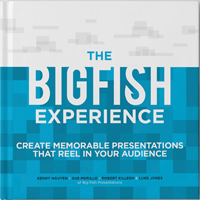Big Fish Picks: 5 Awesome Motivational Presentations
Being a presentation company, we specialize in the structure, design and delivery of quality presentations. We believe that a well-prepared and well-delivered presentation can transform any topic into a memorable, inspiring experience.
One of the ways in which we judge the power of a presentation is by breaking down the elements to see what enchants an audience. Just as a filmmaker dissects his favorite films and emulates them in his own work, our team utilizes these elements in order to give our clients the edge in their next presentation.
So for this blog post we’d like to share 5 presentations that we believe showcase characteristics that make presentations memorable and effective.
1. “Art of the Start” by Guy Kawasaki
[youtube http://www.youtube.com/watch?v=jSlwuafyUUo&w=420&h=315]
Simple and fun, Kawasaki’s most famous presentation combines a little storytelling and light humor to inspire entrepreneurs as well as give expert advice. Humor is one of the hardest things to pull of in a presentation. It’s usually a hit or miss, but Kawasaki delivers. By speaking in a conversational tone, he easily develops a bond with the audience, as if he’ s talking off the cuff to them.
Takeaway tip: Humor is extremely powerful, but difficult to execute. Attempt at your own risk. Make sure to rehearse and know your audience beforehand.
2. “Mystery Box” by J.J. Abrams
[youtube http://www.youtube.com/watch?v=vpjVgF5JDq8&w=560&h=315]
This TED talk by the popular director is very heavy on storytelling and magical in its delivery. Abrams’ electric personality allows him to combine his own personal story and the theme of mystery to form an engaging, inspiring presentation. From the beginning, he establishes the character of his grandfather and makes the audience feel as if they already know him. This allows them to join Abrams on a personal journey as if they are a close friend.
Takeaway tip: Characterization is one of the key points of storytelling. Identify a figure in the beginning of your presentation that the audience can relate to in order to make the audience feel as if they are a part of the story. Forge an emotional bond with your audience to win them over.
3. Steve Jobs’ 2005 Stanford Commencement Address
[youtube http://www.youtube.com/watch?v=UF8uR6Z6KLc&w=420&h=315]
Steve Jobs exudes confidence and inspiration in this 3-part story. This presentation follows the storyline of a young, ambitious Jobs in several eras of his life. Jobs tells of his shortcoming and his successes and still finds a way to relate to college students despite being a billionaire.
Takeaway tip: Make yourself relatable to the audience. You should be able to talk to your audience in a candid way without making them feel inferior. Be humble.
4. “Schools Kill Creativity” by Ken Robinson
[youtube http://www.youtube.com/watch?v=iG9CE55wbtY&w=420&h=315]
Here’s another TED talk that delves into the heavy concept of education with light humor and many quick stories. Robinson’s analogies and insights are playful, yet deeply thought provoking. The key attribute in this presentation is the use of the narrative to illustrate particular points.
Takeaway tip: Statistics and concepts can be hard to grasp. Use various examples to increase your audience’s understanding of your message. A simple story can transform a difficult notion into a simple idea that the audience can easily digest.
5. Benjamin Zander On Music and Passion
[youtube http://www.youtube.com/watch?v=r9LCwI5iErE&w=560&h=315]
As a composer and a teacher, Zander brings musical flare to the presentation, using the piano instead of words to tell his stories. Full of passion and quirks, Zander keeps this presentation very entertaining from beginning to end. This talk is an example of the effective use of stage props and dynamic movement. By incorporating the message with a live performance, the audience is able to remember and enjoy the presentation more effectively.
Takeaway tip: Use the stage and props to your advantage. While words alone are powerful, they are even more impactful when combined with additional movements, symbols and sounds.
All of these presentations exhibit characteristics that we find capture audiences’ attentions, build suspense and deliver powerful messages. The speakers are talented and experienced, and the structure of each piece is designed very cleverly.
However, the speaker doesn’t always have to possess such charm or wit as these do. Anyone can do it with enough practice and passion. All it takes is belief in yourself and your message, and you can deliver an excellent presentation.
So, what do you think about these presentations?
Are they as good as we say they are?
Does one in particular catch your attention?




Share your opinion.